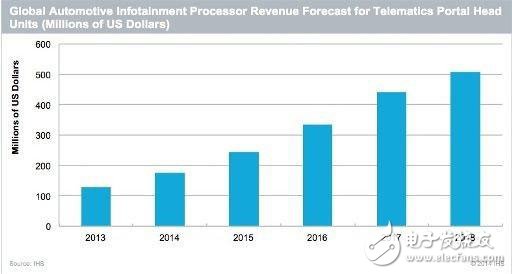In-vehicle infotainment system: smartphones play an important role
According to market research firm IHS, the most breakthrough trend in the in-vehicle infotainment industry is the use of smartphones in cars. However, as smartphones are commonly used in today's automobiles, head-end devices and in-vehicle communication portals that affect cars must be designed, resulting in changes in microprocessor requirements for these components.
IHS believes that this trend presents challenges and opportunities for semiconductor suppliers. In-vehicle communication communication head-end equipment in automobiles will provide semiconductor suppliers with the most promising development prospects. These headend devices use a smartphone as a broadband modem to provide mobile radio access, as well as to connect vehicles to the Internet. IHS predicts that processor chip revenue built into the head-end equipment of telematics will grow to $508 million in 2018, a figure that was less than $128 million in 2013.
With the advent of connected cars, the importance of this application market is significantly increasing. Tom Hackenberg, senior analyst at IHS's microcontroller market, believes that in 2013, vehicle-borne communications head-end equipment accounted for about 8% of the entire automotive infotainment processor market, and is expected to climb 30% by 2018.
On the other hand, the head-end equipment for navigation, which accounts for the highest revenue in the automotive processor market in 2013, will shrink sharply by 2018. By then, its revenue will drop from 368 million in 2013 to 5,800. One hundred million U.S. dollars. The main reason is that navigation devices have become standard equipment for smartphones.

Connected cars drive demand for microprocessors in telematics headend equipment
To meet customer preferences, OEMs are offering more and more integrated systems. For example, an infotainment system integrates functions such as a networked display, control functions into a steering wheel, and a larger touch screen. In addition, the car will have the ability to connect to the various integrated systems in the car using the user's smartphone to provide a richer user experience. However, as this trend develops, for aftermarket suppliers, how to surpass the pre-installed high-integration infotainment system will put pressure on them.
Nonetheless, automotive OEMs face significant challenges when competing to develop systems with rich media experiences for automobiles. A feature-rich infotainment system carries the risk of importing flaws or incompatibilities in important electronic systems, which can lead to liability issues. However, according to IHS analyst Hackenberg, the biggest risk is the danger caused by driver distraction.
Whether or not there is a high risk, OEMs must weigh these concerns and the user experience. Especially in a generation of drivers who are familiar with the rich networking capabilities of smartphones at any time, the networking options of smartphones are always considered insufficient, and may also damage the OEM brand image. IHS analysts stressed that how to find the best balance will bring arduous design challenges to the next generation of telematics systems.
Air Conditioner Purifier,Wall Mounted Air Cleaner,Wall Mountable Air Purifier,Hospital Air Sterilizer
Dongguan V1 Environmental Technology Co., Ltd. , https://www.v1airpurifier.com